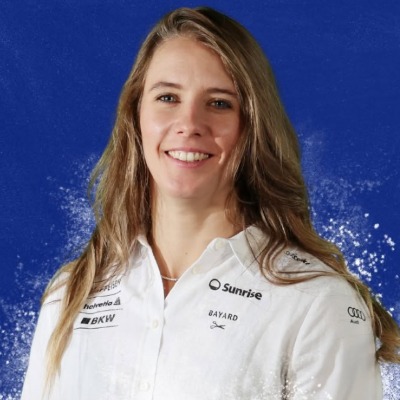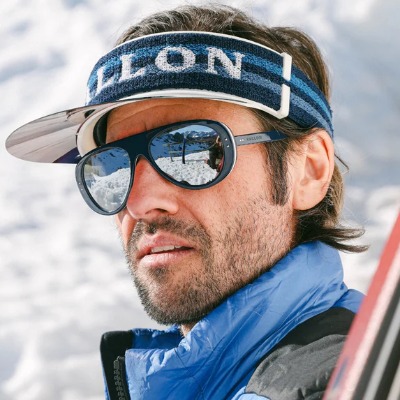Hirscher Foreruns Hahnenkamm, Kilde Wins Friday Race

Aleksander Aamodt Kilde won Friday's Kitzbühel downhill. Kilde was .42 of a second ahead of 41-year-old Frenchman Johan Clarey, who broke his own record as the oldest Alpine skier to make a World Cup podium. Last year in Kitzbühel, Clarey became the first 40-year-old to stand on a World Cup podium, when he was also in second place. France’s Blaise Giezendanner was a stunning third from bib 43.
Due to snowy weather, the iconic Hahnenkamm start moved down the track to the reserve start, cutting the course by five seconds and reducing the flight time on the Mausefalle jump, a treacherous pitch that threw racers about 200 feet down course right out of the gate during training.
“Standing here now just over a year after I had my knee operation it’s quite incredible,” Kilde said. "Today was one of the days when I had a really good feeling. "I don't understand myself why I was so fast. "I've never been like that before."
Travis Ganong led the Americans in the downhill on the legendary Streif in Kitzbuehel, Austria, posting a seventh-place finish. Ganong, who tweaked his back during the previous downhill in Wengen, Switzerland, chose to lay off the gas in training throughout the week to give it everything he had on race day. In combination with a slight course change and a well-executed plan, Ganong trusted his gut and pushed on race day to snag the only top 10 for the Americans.
"The short break we had between Wengen and Kitzbuehel, I was really worried about [my back], and I worked all day every day trying to make it feel better and better and I took it easy on the training runs so I could push on the race day," said Ganong. "Today for some reason I woke up and I felt really good physically, so I decided this morning to push. I love this hill more than any other downhill on the circuit, it's so fun to ski, and it kind of fits more into style and it all worked out today."
Unlike years past, the U.S. men have a second shot at the Hahnenkahmm downhill on Sunday, Jan. 23. Bryce Bennett, who finished 11th on Friday, will seek to push through to the top 10 and reflect his Wednesday training run finish in seventh. Steven Nyman will try to improve on a 21st-place finish and break into the top 20. Ryan Cochran-Siegle will look to avenge past crashes on the Streif and improve his finish of 38th. Sam Morse looks to improve on 37th, and Erik Arvidsson will make his second-career start in Kitzbuehel. Arvidsson crashed and DNFed on Friday, but he was thankfully able to get up and ski down.
The race had a famous forerunner. Austrian alpine skiing star Marcel Hirscher is no stranger to being at the forefront of a global ski race, but how did the retired legend handle being a forerunner at the legendary Hahnenkamm downhill down the fearsome Streif course in Kitzbühel?
The hype around the 82nd edition of the iconic Hahnenkamm weekend went up a level with the news that eight-time FIS World Cup overall champion Hirscher was to return for his 'last great adventure'.
Hirscher, who retired in 2019 with two Olympic golds and seven World Championship titles to his name, fulfilled a dream by speeding down the iconic Streif course as an official course forerunner on Friday morning.
With a further Olympic silver medal, four World Championship silvers, 12 other FIS World Cup discipline titles and 67 World Cup race wins, the Salzburg native is widely regarded as the best alpine skier of all time.
Nevertheless, the 32-year-old has always dreamed of becoming one with a racecourse on two skis and there was only one course he believed was right for the task the challenging Streif run.
Hirscher revealed: "Kitzbühel has always been the last great adventure for me in skiing. The Streif experience was still missing for me. This myth absolutely has its justification and, as a successful skier, you want to be able to have your say there. The slalom is a zigzag that constantly decides between failing and getting through. In contrast, here for the first time, I have the feeling that I am in harmony with the course. The gates are only there to point in any direction. Ultimately, however, the track itself sets your rhythm. This feeling of being part of the track is mega nice!"
He says:
Let's start at the beginning: because I'm not really in a race training routine anymore and I'm not in the same physical shape I was during my professional career, it was necessary to define my Streif project in advance and to approach it slowly. It's not a small challenge, but it is a very nice one, which I now want to be able to experience and master. It's also a great privilege for me as a technology expert to be able to get to know downhill skiing a bit more intensively now that I've had some time after my active career. That's all great fun.
So, instead of the backcountry, I suddenly found myself on the ski racetrack. In my head, I immediately compared it to motocross riding, which I also do in my free time: it's like switching from being on the MX machine to riding a MotoGP™ bike at the Red Bull Ring. Or, to stay with skiing, all of a sudden I'm going from the zig-zag hacking of slalom, where centimetres are important, to what feels like free descent, where metres are important. The feeling of releasing the skis and being in the flow of the elements and nature is great and worth all the effort.
So now for downhill! What does that even mean? For me, as a former slalom skier, it's a novelty that the gates on the descent are just markers that show me roughly where to go and the rest is determined by the route alone. The descent isn't so much of an obstacle course, where you have to worry about whether you can get through at all. The feeling is much more pleasant – you're part of the track, not its opponent.
To cut a long story short: skiing down the Streif is super-exciting for me. Gliding through such long stretches is a big change. You have to concentrate on completely different things than in slalom. So that I don't miss any details during the switch, I divided the Streif into three sections at the beginning:
- The start and the Startschuss
- The middle section with the Seidlalm
- The Hausbergkante and Zielschuss
At first I approached these three sections individually, but I ended up stringing them all together to fulfill another dream.
It was amazing how quickly in the preparation for my Streif adventure that I got back into the exact same old patterns I was in during World Cup times. Even the setup was the same: 5:30am alarm clock, long journey, on-site, warm up, preparation, training, pressure, stress, driving home in the afternoon, cycling, fitness training, therapy, eat, sleep, repeat. And here I have to be honest, as nice as this experience has been again, going through this daily routine again just showed me how satisfied I am with my decision not to actively participate on the racing circuit any more.
Just like back then, my team included my dad, Ferdl, my physio Alexander Fröis and my fitness trainer Gernot Schweizer. My brother and the entire Van Deer crew were new. The latter, as my short downhill adventure also showed, still have a lot of work and a lot of testing to do with athletes on our downhill skis. But here, too, as a new ski brand, I have to say: working on your own skis is a big challenge, but a great one that fills me with pride. I think it's great that we had the courage to take this step. Now the team has to go the extra mile in order to be able to create the perfect ski for every discipline.
With this in mind, I'm saying goodbye and I'm really looking forward to racing towards another dream on Saturday as part of the 82nd Hahnenkamm race on the long skis. Although – and I mean this seriously for the first time in my life – this time I'm at the start to have fun, not to be fast.
Hirscher's career path of either targeting the technical or speed events was decided around the age of 15 and he went on to become the most dominant slalom and giant slalom skier of his generation.
Despite perfecting one aspect of skiing, he did not take his latest challenge lightly and planned meticulously with the help of a well-rehearsed team and former FIS World Cup circuit friends.
He added: "It was clear that if I ever had the chance to race here, I had to take it. It's a huge privilege. We knew that if we tackled The Streif, we had to take it very seriously and implement it in the most professional way. Hats off to any downhill racer, man or woman. It's an insane challenge in terms of courage. The downhill skier is simply a wild animal."
Hirscher's fitness is still excellent and accordingly the speed rookie had the number "F3". His role as a forerunner helped to provide crucial information about the course conditions to the race directors. As Hirscher admitted: "It's not about being fast, it's just about having fun!"













